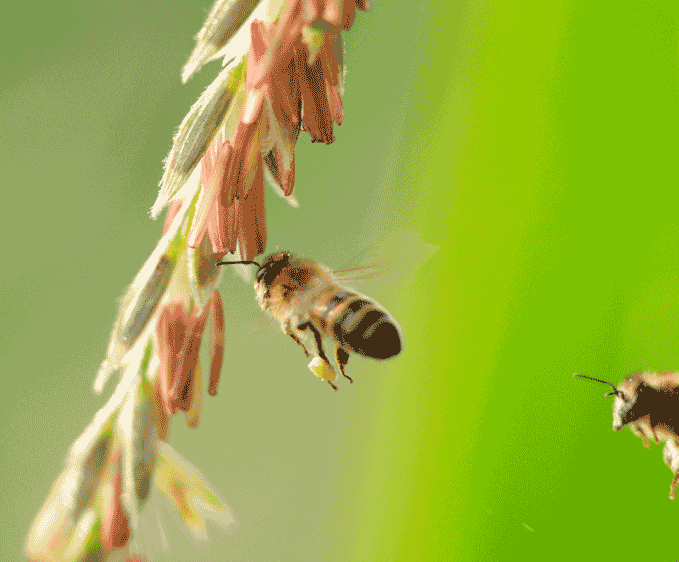Farmers needed in fight to save hives
BEES DYING DESPITE BEST EFFORTS
farmers are generally pretty knowledgeable about the birds and the bees. But before you pull the sprayer out this spring, experts want to remind everyone to keep communication a key strategy in your spring playbook.
The plight of the honey bee has made national headlines in recent years and beekeepers continue to face excessive mortalities every spring. It has never been more important for grain farmers to be well educated about honey bee behaviour and conscious of insecticide use on crops. Paul Kozak, Provincial Apiarist with the Ontario Ministry of Agriculture, Food and Rural Affairs, says that the goal isn’t to discourage farmers from spraying at all but it is important to follow simple best management practices whenever possible. When that’s not possible, Kozak says that most beekeepers understand the challenges farmers face in protecting their crops and can work with some pesticide exposure as long as they’re made aware of spray activities.
“We recognize that grain farmers have to manage their pests,” said Kozak. “It’s all about communication”
defending against v. destructor
Beekeepers understand the challenges of pest control. One of the greatest threats to Ontario honeybees today is a parasitic mite called Varroa destructor. Researchers have shown this aptly named mite is causing huge losses to beekeepers, annihilating entire colonies across the country throughout the winter months.
Dr. Ernesto Guzman, a researcher with the University of Guelph’s School of Environmental Sciences, led a study in 2009 to survey the damage being caused by the mite. Of the 400 colonies they surveyed, Dr. Guzman says they saw 30 percent of the colonies die that year and 85 percent of the mortalities were associated with V. destructor. Because V. destructor is difficult to spot with the naked eye, it’s hard to physically see the harm being done says Dr. Guzman, but the enormity of the mite is a serious problem for the bees.
“Varroa destructor is as small as a pinhead, invisible to the eye, but it’s huge compared to the relative size of the honey bee,” said Dr. Guzman. “Imagine a tick, the size of your fist or a rat, sucking your blood… you wouldn’t live very long!”
Like rats, these parasites can also carry and transmit diseases as they feed. Dr. Guzman and his team are closely studying the immune systems of bees to understand the role these viruses play in further weakening the strength of the hive. They are testing a number of potential pesticides to help the bees fight back against V. destructor. But the nature of the honey industry and consumer demand means synthetic solutions aren’t viable options. A natural solution offers the best option says Dr. Guzman, giving beekeepers a year-round remedy that won’t contaminate honey in the hive and additionally pose no risk of resistance development. The team’s progress so far is very encouraging says Dr. Guzman, and he hopes their efforts can help bring a commercial product to the market soon.
“Essential oils of thyme and oregano are showing some promise,” said Dr. Guzman, “but we still need more time to establish formulation recommendations and acquire the information required for registration with the CFIA.”
honey bees as pollinators
Those who know the value of bees hate to think of the impact to agriculture if time runs out on experts like Dr. Guzman. Nancy Comber, Promotions Coordinator with the Ontario Beekeepers Association, says honey bees are the most important pollinators to agriculture in Ontario. Compared to their native cousins she says honeybees are proving far more suited to the task of keeping up with the pollination demands of the modern farm.

“Agriculture and Agri-food Canada states that Canada’s bees are credited with providing up to $1 billion in increased agricultural production annually,” said Comber. “Although agricultural productivity is now far higher that it was, native bee populations have been reduced.”
Comber says honey bees don’t really play a role in pollenating crops like corn or wheat, though they do forage in and around these crops, but canola and hayfields are highly reliant on bees. There’s also some evidence to suggest bees may help to assist in soybean pollination. Some farmers swear they see higher yields when hives are located nearby. Though they may not be able to substantiate these claims, both Comber and Guzman agree that bees are undeniably linked to a healthy agricultural industry and that it’s in the best interest of anyone who eats in North America for bees to survive.
“Honey bees are responsible for one third of the food consumed in Western society and that’s why we need to try to keep them alive,” said Dr. Guzman.
be conscious of bees
- According to Paul Kozak, farmers can help protect our bees in a number of ways.
- Be aware of hives that may be located on or near your property and if they are within drift distances.
- Contact the beekeeper if you plan to spray, giving two to three days’ notice, if possible.
- Be sure to mention the product you intend to use because some products are harmless and will not require any action from the beekeeper.
- If you’re not sure whether a product is dangerous to bees or not, look for information about toxicity on the label or refer to OMAFRA’s Relative Toxicity of Pesticides to Honeybees Table (Table 1).
- Whenever possible, substitute high impact for low impact products.
- Avoid extremely toxic pesticides like Furadan, which is registered for corn, canola, mustard and sunflowers, and has caused more confirmed cases of poisoning in Ontario than any other Group I pesticide. Insecticides with short residual life cycles are ideal and early morning or, more preferably, evening applications are always the safest for sleeping bees.
| Group I Pesticides Highly Toxic to Bees |
Group II Pesticides Moderately Toxic to Bees |
Group III Pesticides Relatively Non-Toxic to Bees |
|
Severe losses may be expected if the following materials are used when bees are present at treatment time or within a few days thereafter: Admire |
These can be used around bees if dosage, timing, and method of application are correct, but do not apply them directly on bees, in the field or at the colonies: Carzol SP |
Aliette WDG Apollo SC Benlate T-N-G Bioprotec CAF Botran 75W Bravo 500 Captain 80 WDG Confirm 240F Copper 53W Dipel 2X DF Dithane DG Dithane M45 Elevate 50 WDG Equal 65 WP Ferbam 76 WDG Folpan 50WP Foray 48BA Funginex 190 EC Gavel 75 DF Kelthane 50W Kumulus DF Manzate 200 DF Manzate 200 WP Maestro 80 DF Mitac W Nova 40W Penncozeb 75DF Polyram DF Ridomil Gold 480 EC Ridomil Gold MZ Ridomil Copper Ronilan EG Rovral Senator 70WP Streptomycin 17 Topas 250E Vangard 75EG Zineb 80W |







